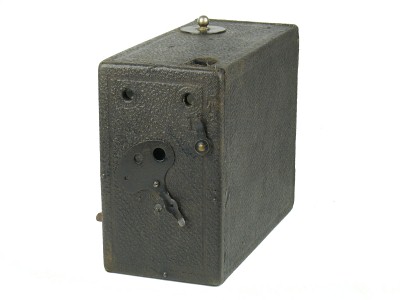Twink Falling Plate Camera
W. Butcher & Co.
| Name: | "Twink" Falling Plate Camera |
| Manufacturer: | W. Butcher & Co. |
| Country of Origin: | United Kingdom |
| Construction: | Leather covered wooden body, with rear door to provide access for
loading the plateholders. A spring attached to the rear door pushes the plateholders
up against a stop, which is connected to the sliding knob on the top of the camera. This is fairly typical of the construction of the European format of falling plate cameras. |
| Production Period: |
| Plate / Film Size: | Vest Pocket 25⁄16" x 1¾" plate |
| Lens: | Simple lens with rotating stops (described as a "Rapid Landscape" lens in the advertisement in the "Prince of Hobbies"). |
| Shutter: | T & I shutter |
| Dimensions (w x h x l): | |
| Date of this Example: | c1914 |
| Serial Number: | No serial number found |
| Availability: |
|
| Inventory Number: | 158 |
|
Photos copyright © 2012 David Purcell. Do not use without permission. |
Description
Conventional pattern falling plate camera, but for vest pocket size plates. Came complete with 5 plate sheaths with plates still loaded. No obvious markings on the camera at all; shutter is labelled T & I. As with many cameras of this type and era, this is almost certain to be of German manufacture.
The camera was bought at a camera fair in Guildford but no identification was put forward by the seller at the time.
Subsequent discussion with the late Eaton Lothrop suggested that this might be a Butcher "Twink", based upon comparison of photographs of one in his substantial collection. This was subsequently confirmed by checking the camera against an advertisement in the "Prince of Hobbies".
The plate changing mechanism varies in design, although most European falling plate cameras use the same basic approach.
In some cases each plateholder is notched at the top but in two alternate positions so that when the plate changing knob is moved, the exposed plate is push forward and falls into the base of the camera and the next plate is pushed forward against the stop, its notch being in the alternate location. (The plateholders must be loaded so that the notch positions alternate).
In the case of the Twink, each plateholder has a tab at the top in a central position which engages with the stop. However, the plate changing mechanism attached to the underside of the knob is sprung and has two stops that are offset. When the plate has been exposed the knob is moved, causing the stop to move aside and thereby allowing the plate to fall into the base of the camera. However a second stop behind the first catches the next plate as it is pushed forward. When the sprung knob is released, the new plate is pushed up against the front stop to align it with the film plane and the process is ready to be repeated.
Notes
Eaton Lothrop was probably best known to European collectors for his publications, most notably "A Century of Cameras" [5]. He had a remarkable collection of cameras and was always ready and willing to share his knowledge with others.
"The Prince of Hobbies" is a small book of about 190 pages, almost all of which is given up to a catalogue of Butcher equipment including Cameo, Klimax & Carbine cameras. The edition I have is not dated directly, but inside the back cover it includes an advertisement for the BJPA stating that the 1915 edition will be available as of Dec 1914. It is reasonable to assume therefore that the catalogue dates to 1914. The price of the camera in 1914 was 3 shillings.
![[ ]](../../images/unchecked.png)
![[x]](../../images/checked.png)








